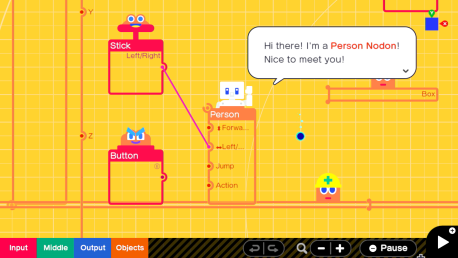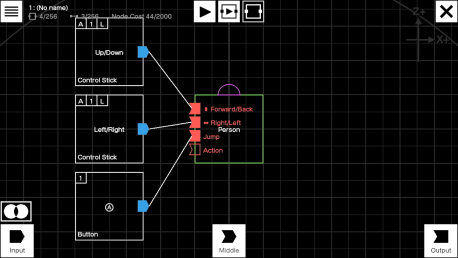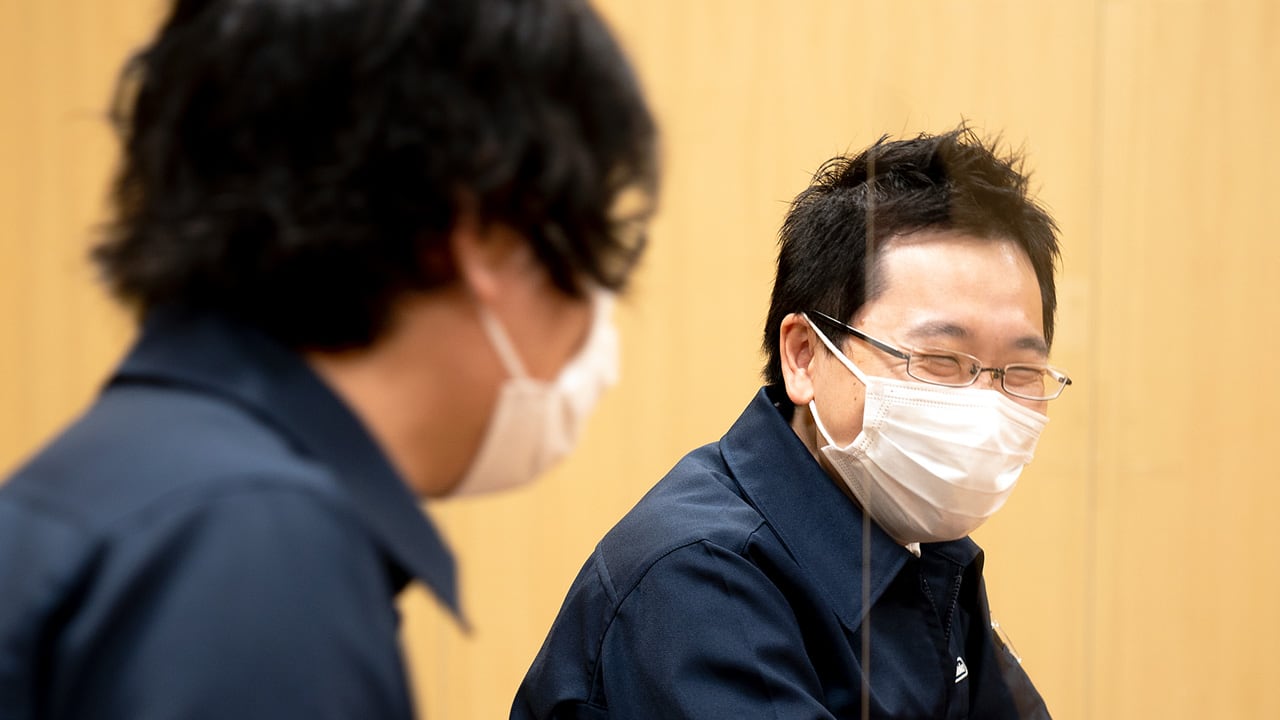
2021.6.10
Content pre-recorded in accordance with current COVID-19 health and safety guidelines. This article has been translated from the original Japanese content.
To kick off this Ask the Developer series, in which Nintendo
developers convey in their own words Nintendo’s thoughts about creating products and the specific
points they are particular about, we are talking to two people who were involved in developing
Game Builder Garage
, now available on
Nintendo Switch.
First, could you briefly introduce yourselves and talk
about the work you have been in charge of so far?
(referred to as Masuda from this point on)I'm Masuda, the director and programmer of Game Builder Garage. Previously, I was in charge of the planning and programming of 『Nintendo Labo』(1)
(1) Nintendo Labo kits provide players with the tools to build and play with various “Toy-Con” creations – such as pianos, motorbikes, and robots – by combining cardboard and the Nintendo Switch console.
(referred to as Teshima from this point on)I am Teshima. As a subdirector, I was in charge of coordinating the Interactive Lessons for Game Builder Garage. Before that, I was involved in creating the text for the Discover(2) portion of Nintendo Labo.
(2)The Discover portion of Nintendo Labo is where players can learn how the Toy-Con work.
Thank you very much. So, could you briefly introduce Game Builder Garage?
Sure. Game Builder Garage is software that makes programming your own games easy and fun, simply by connecting mysterious creatures called Nodon. Even if you feel that programming is difficult, you will gradually understand it with easy-to-understand steps in the “Interactive Lessons” and eventually can create your own games.

What was the motivation behind the design of this software?
After developing the Nintendo Labo: VR Kit, which was the fourth installment in the series, I wondered if we could draw inspiration from the Toy-Con Garage VR portion of that game to create a separate product. In the case of the Nintendo Labo: VR Kit, after the player had a general understanding of creating Toy-Con, they could enjoy making their own VR games with Toy-Con Garage VR. But I thought about making the applications more broad – not just for VR.

Did you feel like you had some unfinished business with Toy-Con Garage?
No, not exactly, but I did feel that we could evolve it further. The Toy-Con Garage tool is the final practical application part of the Nintendo Labo: VR Kit, and at first, we expected that only a handful of people would get to it. However, after holding a Toy-Con Garage contest, I realised that there were many interesting and rewarding games among all of the original games created by players using Toy-Con Garage, and I wanted more people to experience the joy of creating their own games. I also wanted to find a way to make it easier for people to have the fun of creating games through trial and error.
Even within the development team for Nintendo Labo, designers who don't usually do programming have been using the Toy-Con Garage feature to create their own games. But sometimes, they’d stop part way through, because they didn't know how to continue making the game they wanted to make. And then they would come and ask Masuda-san, who developed the Toy-Con Garage. And they gradually learned how to make games. At that time, Masuda-san answered all their questions, so you became like their technical support, didn’t you? (laughing)
After hearing all those questions from designers and seeing all the games created by players, I realised that this Toy-Con Garage portion is fun and that we might be able to expand that fun if we had a system that provides guidance on how to create games using Toy-Con Garage, making it more approachable for players.
In other words, the challenge with Toy-Con Garage was about explaining how to create, and your objective this time was to resolve that challenge?
That’s right. With the Nintendo Labo series, you learn how the hardware works by making and playing with the cardboard Toy-Con. And then, by applying that knowledge, some people could go as far as creating their own original games using Toy-Con Garage. By acting as “technical support” and answering those questions from our designers, I thought, “What if I turn this order around?”. To put it another way, Nintendo Labo started by providing an understanding of how the hardware worked and eventually led to the creation of software, while Game Builder Garage uses the creation of software as an entry point for the user to experience programming first-hand. Nintendo Labo has the “Make” portion, which I personally think are the coolest assembly instructions in the world, and I thought of applying this know-how to the “make” part of programming. I thought this would help people enjoy the “Make, Play, Discover” aspects of Nintendo Labo from a different angle.
In other words, you wanted to bring the final software creation elements of Nintendo Labo to the fore.
Yes, and just like Masuda-san became "tech support" for the designers, I thought if there were a guide or navigator for the players, they would better be able to enjoy the possibility of being able to make their own games!
Then, the tutorial guide for the interactive lessons is…actually, Masuda-san?
Yes, I guess you can say that it’s Masuda-san's alter ego. (Laughing)

I’m curious about the navigator – Masuda-san’s alter ego. What exactly is this “navigation” in the interactive lessons?
To what extent will the players be guided?
At the start, an instructor character named Bob appears. He will guide you every step of the way. Characters called “Nodon” are used for the actual programming, and Bob moves around the screen as the player manipulates these Nodon characters. Bob gives detailed instructions from start to finish, such as "Put a Nodon here" or "Connect this Nodon to that Nodon".
I see. It seems that even beginners can finish making a game. By the way, can elementary school students also enjoy programming?
We asked elementary school students who were interested in programming to play the software in the development stage.
And what was their reaction?
Their reactions were really encouraging to us. On the spot, the students were able to reach the stage where they could get through the lessons we could prepare at that time… Well…they did more than get through it… Those students’ enthusiasm was incredible… (Laughing)
They were like, “More! More!”. They weren’t satisfied with just the lessons we had prepared for the monitor testing, and we ended up finding ourselves in deep trouble when the students started to try out some unfinished parts that were still in development. (Laughing)
Their concentration was amazing. (Laughing)
(Laughing)
In addition, a fourth grader even created his own game through the Free Programming part of the game beyond the interactive lessons, which made me realise that we were on to something.
I see, so it has been proven that even elementary school students can actually create games.
Of course, individuals are going to come to the game with different skill levels.
Is it safe to say that the interactive lessons will help with those differences?
Yes, it is. The lessons are designed so that even first graders can make games while having fun. On top of that, there’s also a mode that teaches you more about the mechanics and the Nodon characters that were mentioned in the lesson. And if you want to do more, you can try Free Programming. I hope that having multiple options will help players of different skill levels enjoy the game.
